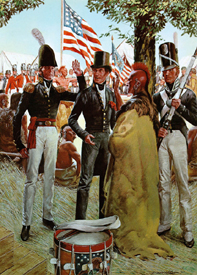Рождение Федерального Резерва (три войны - три банка).

В первой части своего рассказа " Рождение Федерального Резерва (пролог)" кратко обрисовал историю создания Первого и Второго банков США (First Bank of United States/Second Bank of United Stated), но за рамками осталась очень существенная деталь создания этих банков - исторический контекст, который нельзя упускать из виду и события произошедшие в это время имеют очень важное значение для понимания финансовой системы США.
Всего за период восемнадцатого - девятнадцатого веков в истории США было три ключевых момента, во время которых предпринимались и, соответственно, приводились в жизнь, попытки наведения порядка в финансовой сфере. На этот период так же пришлось три войны - первая война за независимость (создание Первого Банка США), вторая война за независимость (создание Второго банка США) и Гражданская война (создание системы резервных банков).
В дополнении ко всему, в промежуток времени между второй войной за независимость и Гражданской войной произошло два знаковых события - полная выплата государственного долга (федерального) и дефолт штатов (дефолт по долгам объявили восемь штатов + Территория Флорида) и эти события до сих пор вызывают неоднозначную реакцию и вызывают закономерный вопрос - возможно ли такое повторение в будущем?
Выплата государственного долга (Debt Zero) пришлась на время президента Эндрю Джексона, ярком стороннике политики Томаса Джефферсона. Парадоксально, но так же считается, что политика Джексона по снижению долговой нагрузки в 1831 году привела к дефолту 1837 - 1843 годов.

Between the years 1833 and 1838 additions were made to bank capital and bank issues, in the form of notes designed for circulation, to an extent enormously great. The question seemed to be not how the best currency could be provided, but in what manner the greatest amount of bank paper could be put in circulation. Thus a vast amount of what was called money, since for the time being it answered the purposes of money, was thrown upon the country, an over-issue which was attended, as a necessary consequence, by an extravagant increase of the prices of all articles of property, the spread of a speculative mania all over the country, and has finally ended in a general indebtedness on the part of States and individuals, the prostration of public and private credit, a depreciation in the market value of real and personal estate, and has left large districts of country almost entirely without any circulating medium.
The panic of 1837 was not due solely to the causes above enumerated. Many influences converged to produce this result, and to give rise to the fever of speculation which was its immediate predecessor. As one of its results the banking system of the country suffered a general collapse. Out of eight hundred and fifty banks, three hundred and forty-three closed entirely, sixty-two failed partially ,and the system of State banks received a shock from which it never fully recovered. The compromise tariff of 1833, though which the tariff was to be annually reduced until it should reach a general twenty per cent. Level in 1842 added to the distress, and recovery only fairly took place after 1842 in which year a few tariff bill was passed, imposing a thirty per cent. ad-valorem rate on all imported goods except in certain special cases. In 1846 a low tariff bill was again passed, which continued in force until 1860 when in the Morrill tariff bill was resumed the protective principle which has been ever since maintained.
Более подробно с событиями того времени можно ознакомиться в специализированной литературе:
A HISTORY OF MONEY AND BANKING IN THE UNITED STATES: THE COLONIAL ERA TO WORLDWAR II (Murray Rothbard)
"Land, Debt, and Taxes: Origins of the U.S. State Default Crisis, 1839 to 1842" (John Joseph Wallis, Richard E. Sylla, and Arthur Grinath III)
"Sovereign Default and Repudiation: The Emerging-Market Debt Crisis in U.S. States, 1839-1843" (John Joseph Wallis)
P.S. Добивать статью буду после возвращения из поездки.